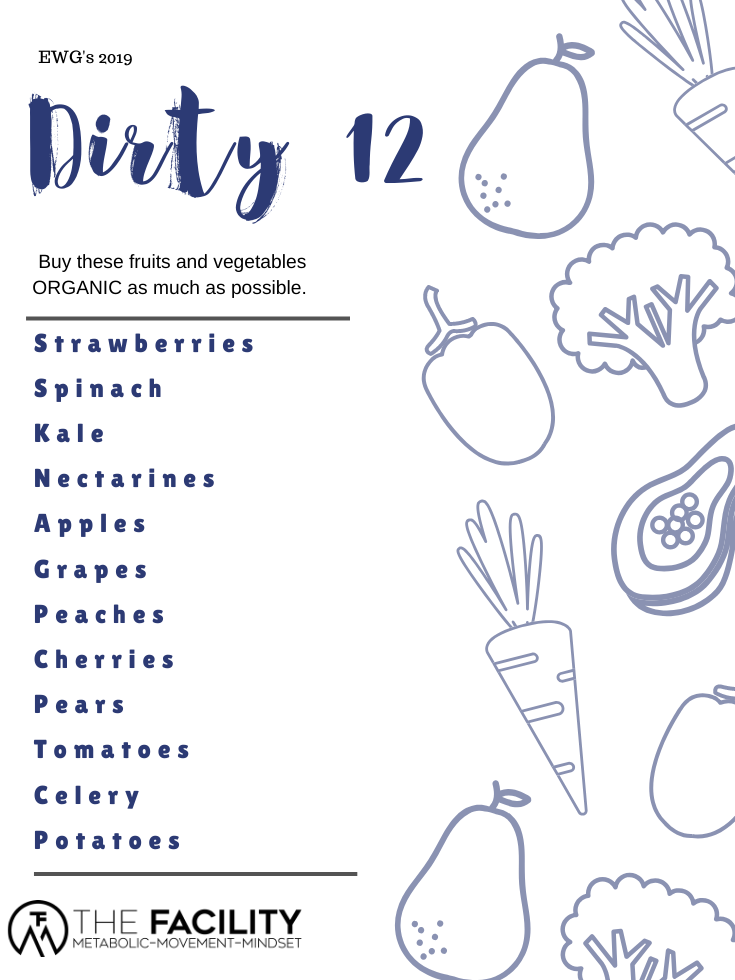When to Buy Organic: The EWG's Clean 15 (& Dirty Dozen)
- The Facility Denver

- Nov 2, 2019
- 2 min read
I often get asked about the importance of eating organic. When it comes to produce, often the cost is a barrier. The organic produce can be three times more expensive.
Although I do my best to choose organic produce, there are certain barriers that prevent an exclusively organic diet: even for a nutritionist!
Instead of thinking about the organic label, consider how the food was grown and where it was sourced. Often, small, local farms are using organic practices (no pesticides, no GMOs). Despite adhering to standards, they may not get a costly organic certification. During the seasonal months, spend time at the local farmer’s market talking to your local farms. Ask about their growing practices.

At grocery stores, I use the Dirty Dozen and Clean 15 lists to choose what produce I will buy organic.
The Environmental Working Group (EWG) is a non-profit organization that strives to protect human health and the environment. They educate the public on genetically modified organisms, pesticides in food, tap water standards, and even the safety of personal care products and cosmetics.
The EWG’s Shopper’s Guides to Pesticides in Produce is updated each year and ranks pesticide contamination on 48 top fruits and vegetables. The guide is based on tested laboratory samples from the U.S. Department of Agriculture and the Food and Drug Administration.

The Clean 15 are the top 15 foods with the least pesticides, while the Dirty Dozen is a list of the 12 foods with the most pesticides. This list helps guide decisions in the produce aisle: particularly when it comes to cost. I make sure that I exclusively buy organic for items on the lower end of the list; and can be a bit more lenient with the Clean 15.
The Dirty Dozen
-Strawberries -Spinach -Kale
-Nectarines -Apples -Grapes
-Peaches -Cherries -Pears
-Tomatoes -Celery -Potatoes
The Clean 15
-Avocado -Sweet Corn -Pineapples -Peas
-Onions -Papayas -Eggplants -Asparagus
-Kiwis -Cabbages -Cauliflower -Cantaloupes -Broccoli -Mushrooms -Honeydew Melons
You can find the full EWG 2019 Report here.
Note these key findings:
Avocados are the cleanest. Less than 1 percent of samples showed any detectable pesticides.
More than 70 percent of the Clean 15 fruit and vegetable samples had no pesticide residues
Remember that many common foods fall somewhere in the middle.
Still opt for organic as much as possible.
If something is very high in price, consider choosing an alternative fruit or vegetable that is in season. Consider buying organic frozen fruits and vegetables which were harvested during peak season. Shopping seasonally gives you greater variation in your diet, ensures lower prices, and often sources food closer to home.
Don’t be discouraged when conventionally grown fruits and vegetables are a staple in your diet. Fresh produce is better than no produce: just ensure that you are washing everything thoroughly (This will reduce, but not eliminate exposure).
Keep these lists handy as you do your shopping.




















Comments